He Was Hit by a Russian Mortar and Asked to Be Left Behind. Now He Wants to Fight Again

“Your father is dead.”
When the commander called, Angelina Alexandrova felt the world collapse. Her father, Vyacheslav Alexandrov, was a 46-year-old Ukrainian soldier from the central city of Kryvyi Rih. He had been in a trench assault in the Donbas region of eastern Ukraine, and his callsign had been reported dead.
A few hours later, a call came from a member of his unit. There had been a mix-up. Her father had been hit in the assault but was alive. A soldier with a similar callsign had died. It was another family whose life would fall apart. Vyacheslav would make it.
“We were ordered to take a position,” Vyacheslav told Men’s Journal. “We were supposed to be under the cover of artillery, but there was not enough.” The Russian forces repelled their assault with mortar fire, and one shell exploded on top of his unit.
“I heard the whistle coming, and next to me a bomb exploded, injuring my hand and leg. We were under constant attack from tanks while we waited for help, while they were trying to save us.”
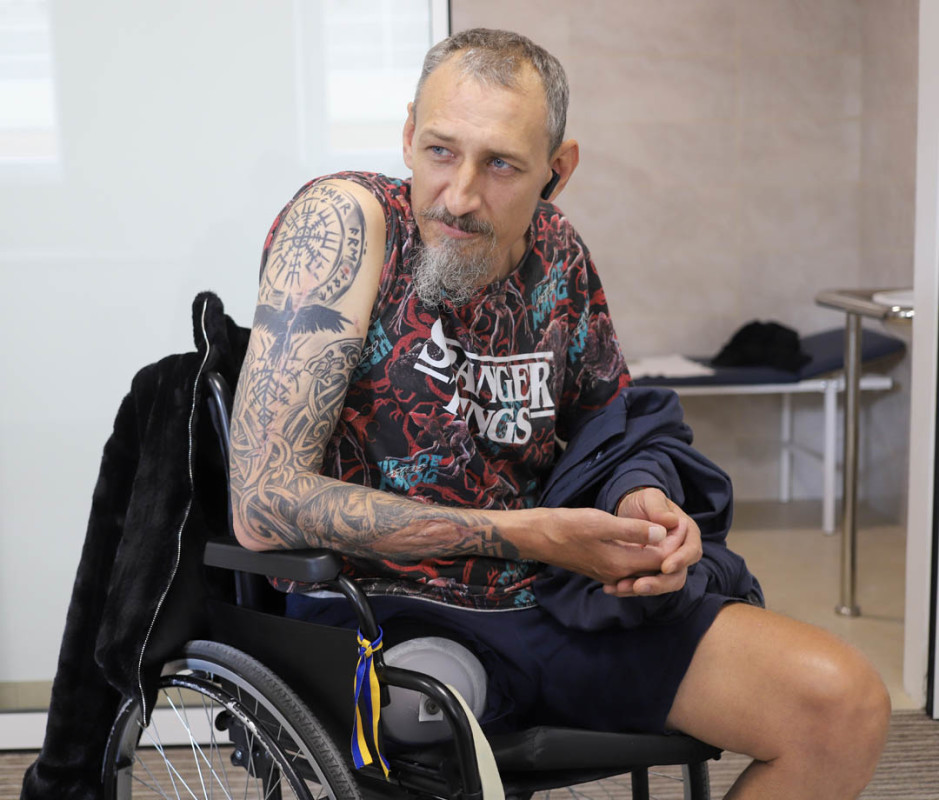 Vyacheslav Alexandrov at the Unbroken Center in October, 2023.
Vyacheslav Alexandrov at the Unbroken Center in October, 2023.
Thomas Mutch
After a night of sheltering under a barrage of artillery fire from both lines, Vyacheslav was taken to a field hospital and then a larger general hospital. His life, and his hand, were saved, but his left leg would be amputated above the knee.
Alexandrov is recuperating in Lviv, a city in western Ukraine near the Polish border, far from the frontlines. Despite the distance, the city has been struck by missiles several times since Russia’s invasion began, killing civilians. But it has escaped the devastation seen in eastern cities like Mariupol, Kharkiv, and Bakhmut. The cobbled streets, considered Ukraine’s most beautiful, are full of bars, clubs, and restaurants—a welcome respite from grinding combat. It’s ideal for the convalescence wounded heroes need. More than five million Ukrainians who left their homes to flee the war have passed through here, and many have moved permanently. In response to the increasing influx of refugees who already put heavy pressure on the city’s health care system, the city administration built a special center for individuals injured in the war: the Unbroken Center.
As an extension of Lviv State Hospital, the Unbroken Center ensures that injured Ukrainian soldiers and civilians can receive all their treatment in a single location instead of searching for help abroad or at various medical facilities throughout the country.
The Russo-Ukrainian war is the largest conflict in Europe since the Second World War, leaving untold destruction in its wake. The exact amount of casualties is a closely guarded military secret, but U.S. intelligence estimated in August 2023—the last time it shared this information publicly—that the number had reached half a million. This included 200,000 Ukrainians, of which perhaps 70,000 were soldiers killed in action. These figures don’t account for thousands of unrecorded minor injuries, healthcare crises caused by shortages of essential goods and services, or the stress endured by survivors.
According to the doctors working at the Unbroken Center, more than 25,000 people lost limbs in the war in Ukraine—around 40 people a day on average. Individuals like Alexandrov receive integrated treatment from a wide range of medical staff members including physiotherapists, orthopedic surgeons, rehabilitation counselors, and psychiatrists. But as the war rages on and more people need care, hospital resources diminish.
About 13,000 cases have come through the Unbroken Center, says Zoriana Hasiy, communications director of the rehabilitation center. But despite being the largest facility of its kind in Ukraine, there are still long waiting lists. The fight to save Ukraine’s injured culminates here, but from the moment a soldier is injured, it’s a long process from rescue, to treatment, and finally to recovery.
After the mortar hit, Vyacheslav looked at his watch. He doesn’t know why. But the memory stuck—it was 9:30 p.m. The pain from the shrapnel was “hellish,” he says. “I thought that my hand was completely torn off.” He crawled toward the Ukrainian line, 44 pounds of ammunition and body armor weighing him down, until his strength failed. He made it maybe 100 meters, but it was enough to find refuge.
He tried to push himself off the ground, but his injured leg—bleeding and numb—kept him down. Prone, he managed to attach a tourniquet to the leg. A fellow soldier radioed for help, but with Russian tanks and artillery firing above, they couldn’t be reached by a personnel carrier. They were three miles from base, and he told his comrades to leave him and head back. “I realized it was worth losing one badly injured person rather than two combat units.” But his colleagues refused, and hunkered down as covering fire from the Ukrainian line held back any Russian advance.
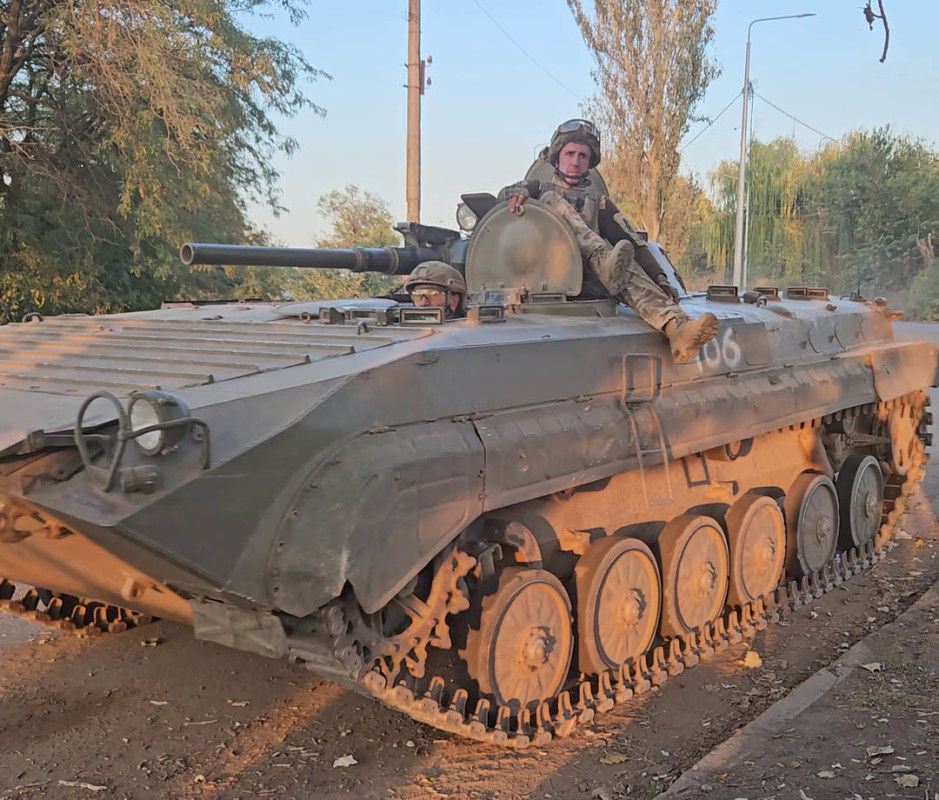 An armored personnel carrier typically used to transport injured soldier to field hospitals. Occasionally, amid equipment shortages, soft-sided ambulances are used.
An armored personnel carrier typically used to transport injured soldier to field hospitals. Occasionally, amid equipment shortages, soft-sided ambulances are used.
Thomas Mutch
Around 5:00 a.m. the next day, an armored evacuation car arrived to load him up. They drove quickly over potholed roads towards a nearby village of buildings recently turned to rubble. The field hospital sat within the ruins, where doctors ripped off Vyacheslav’s clothes and self-made tourniquet to perform emergency surgery. It was the last thing he remembered before blacking out.
These field hospitals, also called stabilization points, are situated three to nine miles from the frontline, well within range of Russian artillery and drones. Teams of trained doctors, including at least one professional surgeon, work day and night to perform lifesaving emergency medical treatment. When possible, they set soldiers up for recovery, preserving nerves to prevent chronic pain and bones to keep limbs intact. They treat all comers, including Russian soldiers that have been left behind.
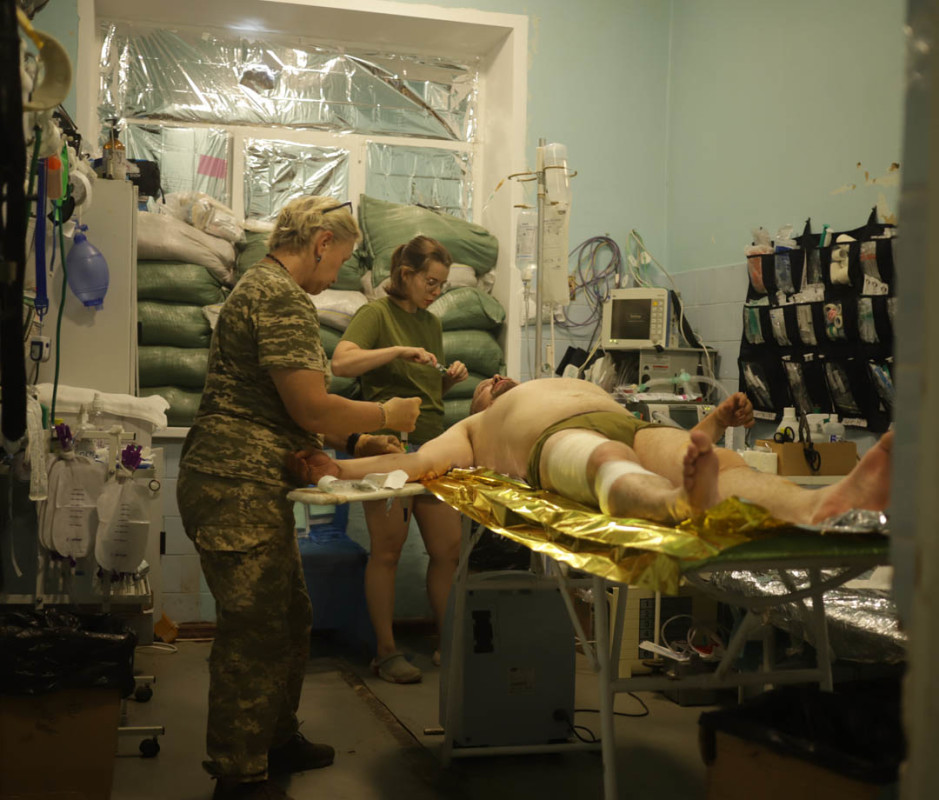 A Ukrainian field hospital in the Donbas region.
A Ukrainian field hospital in the Donbas region.
Thomas Mutch
After Vyacheslav’s emergency surgery, he was driven, unconscious, to a large general hospital in Kharkiv, Ukraine’s second biggest city.
The hospital stay was grueling. “When I woke up, my arm was covered in blood,” he said. ”I was on dialysis in the hospital because my kidneys stopped working.” After subsequent surgeries, the doctors saved his right arm, and he is slowly regaining function in it. But his amputated leg has been a constant source of distress. “At first, I had a prosthetic leg done but then inflammation occurred, and they had to re-do it and fit it to the sizes again. Now, it causes me pain when I move my bones, the muscles hurt a lot. The doctor’s forecast that I will have a long rehabilitation process.”
For rehab, he was transferred to Unbroken.
When I visited Vyacheslav in early October, he had been in the center around three months. We’re waiting in a basement room when a technician arrives with the prosthetic leg. He assists Vyacheslav with the buckles and straps and attaches it to the amputation point around his knee. Vyacheslav settles in at the end of two bars for support, but when he tries to step forward, he grimaces and wobbles. Eventually Vyacheslav drags himself a few paces forward.
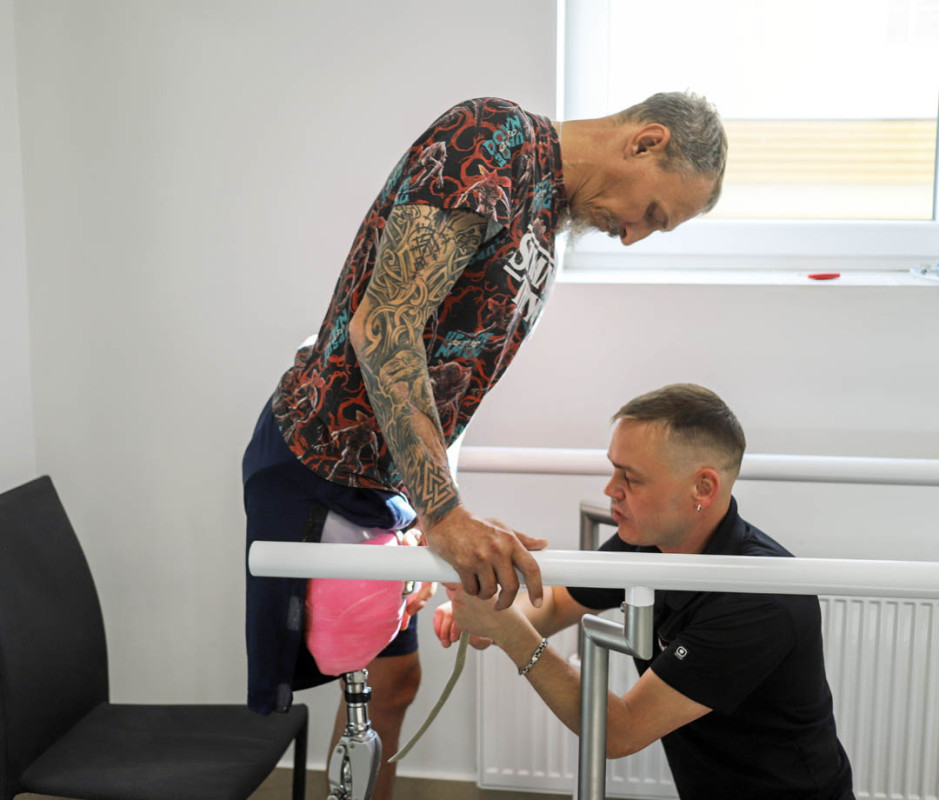 An Unbroken Center technician adjusts Vyacheslav’s prosthetic.
An Unbroken Center technician adjusts Vyacheslav’s prosthetic.
Thomas Mutch
“How’s that?” the technician asks, kneeling immediately with a screwdriver in his hands to adjust the various gears and elastic straps to best adapt his leg to Vyacheslav’s gait. The aim is to keep the foot as maneuverable for the wearer as possible. Tiny changes in length or counterbalance drastically impact mobility.
Solomiya Yakubechko, a spokesperson for the Center, describes some of the different prosthetic procedures they undertake, depending on the patients’ needs and the technology available. “You can have a hand that feels like a human hand, but can’t move, or a mechanical hand that moves,” Yakubechko says. “One younger guy wanted the mechanical one so he could ride his motorbike. And older man, with a family, wanted a human-like hand so it felt more natural for his newborn son, when he held him in his arms.”
When we visit the Center’s rehabilitation gym, we see an instructor is about to begin a physiotherapy group session with five men—three who have lost one leg, one who has lost both legs, and one who has lost his left hand and two fingers on his right.
We watch as they lie down on a soft foam mat on the floor and, under the tutelage of physiotherapist Roksolana Shmylo, start stretches and endurance exercises. Some of them are strong enough to lift weights, while others barely manage a push up.
“The majority of those who come to our treatment are victims of landmines, followed by artillery injuries. Landmines are meant to attack the lower body, which is why it’s very common for people to lose a leg like Serhii,” says Roksolana, pointing to a soldier running back and forth along the hall with a prosthetic leg on his left foot.
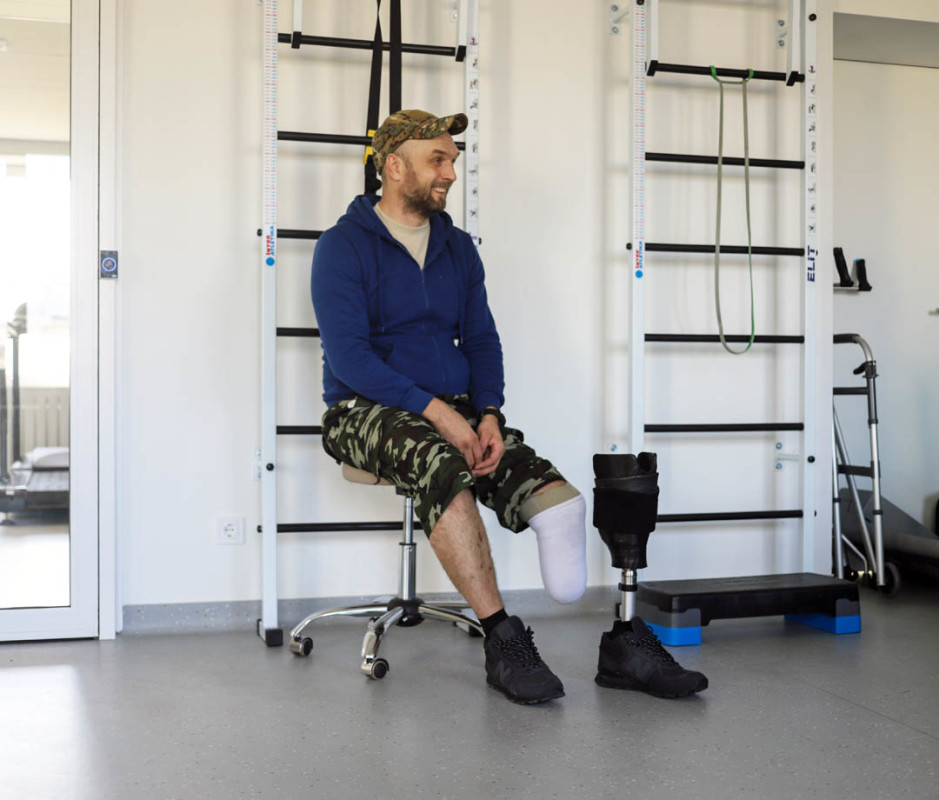 Serhii Yevtushenko taking a break from exercises at the Unbroken Center.
Serhii Yevtushenko taking a break from exercises at the Unbroken Center.
Thomas Mutch
After the group exercise, we speak with 34-year-old Serhii Yevtushenko. “I saw my partner step on a landmine. I ran to him to try to help and I stepped on another landmine hidden next to the first one.”
He shows us a video on his phone taken of him when he has just arrived at the hospital, as his wounds were being treated. There, he sits on an operating table, belting out a famous soldiers’ prayer. “May I know neither fear nor hesitation, strengthen my spirit, harden my will, dwell in my heart,” he says in a hoarse voice, wincing in pain.
Putting away his phone, he recounts, with a smile on his face, that he agreed to the complete amputation of his left leg below the knee after a conversation with the doctors. “They explained to me that there were no prostheses for just the foot, so I told them: cut!”
Now, just a few months later, he’s running—and even skipping—with his new prosthetic leg. “I’m not injured, I’m augmented,” he says. While the other men shuffle out, he talks to us while taking a few turns with the jump rope. He has one purpose for rehab. As soon as he is well enough, he wants to return to the frontlines. He picks up a skipping rope, and after a few false starts, starts a rhythm in which he makes about fifteen jumps in one go. “Slower, concentrate” Roksolana tells him as he catches his metal leg on the cord. He feels guilty for having abandoned his comrades, he says, and is in a hurry to get back.
But even when a soldier recovers, they face challenges and uncertainties inherent in returning to life outside the hospital. According to a 2023 study from the EU4Youth program, more than half of Ukrainian veterans struggle to obtain medical aid and receive social benefits. Bureaucratic obstacles prevent them from obtaining war veteran or invalid status and limit access to reintegration services. “We don’t have enough beds, we don’t have enough places, but we also don’t have enough qualified staff,” says Hasiy.
Veterans deal with a glaring lack of adapted infrastructure, despite the opening of centers such as Unbroken, she says: “Most administrative buildings, public transportation, and housing are not adapted for people in wheelchairs or on crutches.” When asked about Ukrainian society’s ability to meet the needs of this new generation of veterans, Shmylo is also pessimistic: “There is still a lot of prejudice about the mental health of veterans,” she says, before congratulating Serhii, who has just finished his workout. There is still stigmatization of mental health problems, like PTSD, inherited from the Soviet era, according to Hasiy. She says that it will take time for Ukrainians mentalities to evolve on these issues.
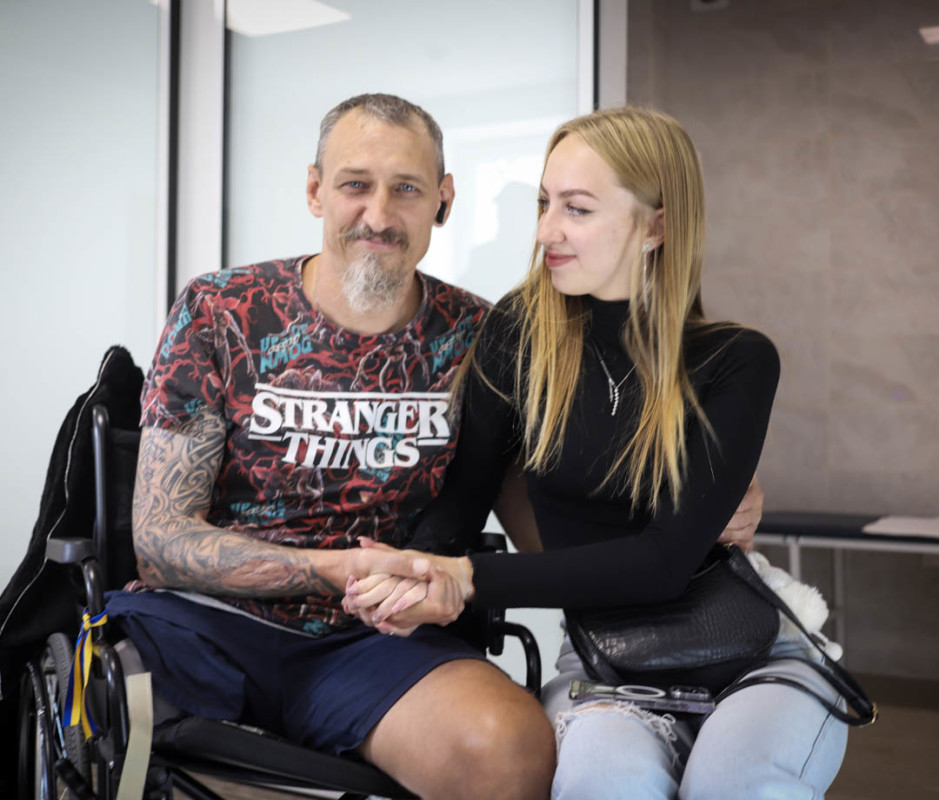 Vyacheslav with his daughter, Angelina.
Vyacheslav with his daughter, Angelina.
Thomas Mutch
When Vyacheslav takes a break, exhausted from his own rehab exercises, he says he believes that most Ukrainians understand and respect the sacrifices made by veterans to defend Ukraine’s independence. “Of course, there will always be 10 percent who cannot, or don’t want to, understand.”
When I first spoke to him, he expressed a desire to return to family life. But when I followed up with him about two months later, he said he believes there is still a position for him in the army. He has a long way to go before he’s fully recovered. But he wants to be back on the front lines, piloting attack drones, he says, supporting his country.
Additional reporting by Olena Skachko.


